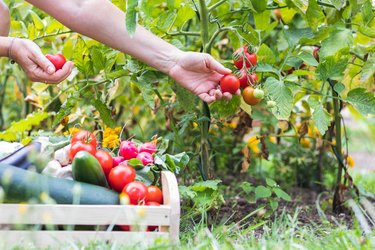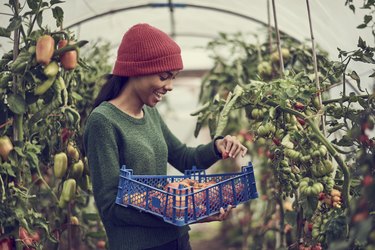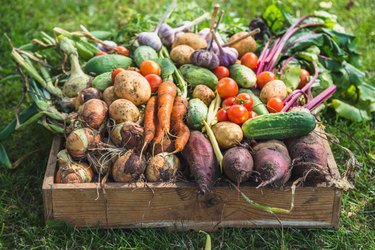
Timing is everything – in life, and in your vegetable garden. If insects are eating your burgeoning vegetable plants, applying insecticides too late means your produce may not be safe to eat by the time it's perfectly ripe. Sevin products, like other insecticides, use a pre-harvest interval (PHI) to determine how long to wait between applying the product and harvesting/eating the produce. Whether you're using liquids, granules or Sevin dust, vegetables are safe after washing – as long as the full PHI has elapsed. Different products use different PHIs for different veggies; check the label on your Sevin insecticide for specific guidance about the plants in your garden.
Harvesting Vegetables After Sevin Dust
Video of the Day
Sevin makes two kinds of dust that are both popular insecticides, largely because of how easy they are to apply: All you have to do is open the canister, sprinkle the dust over any bug-ridden plants and wait for the PHI to pass before harvesting and enjoying the fruits (and veggies) of your labor. Sevin's Ready-To-Use 5% Dust kills more than 65 types of pests, while Sevin Sulfur Dust is a two-in-one product that targets insects and plant diseases.
Video of the Day
Sevin's Ready-To-Use 5% Dust requires longer pre-harvest intervals than some of Sevin's other formulations. Legumes with inedible shells have a PHI of 21 days. Wait at least 14 days after using Sevin dust on collards, kale, lettuce and certain other greens. Radishes, carrots, potatoes and berries have a PHI of seven days. Melons, tomatoes, sugar snap peas and squash have a PHI of three days.
Sevin Sulfur Dust's label breaks down the minimum retreatment interval (how long you should wait after first applying the product before reapplying) for a wide range of fruits and vegetables, but doesn't offer specific guidance about PHI.
Harvesting Vegetables After Liquid Sevin

Sevin liquid products have relatively short PHIs; it's why some gardeners consider them among the best insecticides for vegetable gardens. You can safely harvest and eat many fruits and vegetables just one day after applying Sevin liquid insecticide. This group includes cabbage, collards, summer squash, berries, legumes with edible pods, many root vegetables and leafy vegetables such as arugula and spinach. Sweet corn has a PHI of three days, while stone fruits have a PHI of 14 days, and legumes with inedible shells have a PHI of 21 days.
Harvesting Vegetables After Sevin Granules
Sevin lawn granules are designed to target pests in the lawn and around a home's perimeter. If your vegetable garden is tucked along a wall of your home, you may use a handheld spreader to disperse these granules across all the plant life in the area. This product has PHIs ranging from one day (for tomatoes, garden beets and edible-podded legumes) to as long as 40 days for spinach. Potatoes, soybeans and a number of root or tuber vegetables have a 21-day PHI, while collards, cabbage and pepper have a PHI of seven days.
Best Insecticides for Vegetable Gardens

Sevin products are generally considered among the best insecticides for vegetable gardens, but home gardeners have an array of options. Some prefer to use natural remedies, such as spritzing plants with soapy water or using natural remedies like hot peppers or peppermint oil to discourage insect activity. Some gardeners use products that are derived from bacteria, which can be appropriate for organic gardens, while others are comfortable with chemical products like Sevin. That's why it's hard to definitively name the best insecticide for vegetable gardens: What works the best for your garden depends on your priorities and preferences.